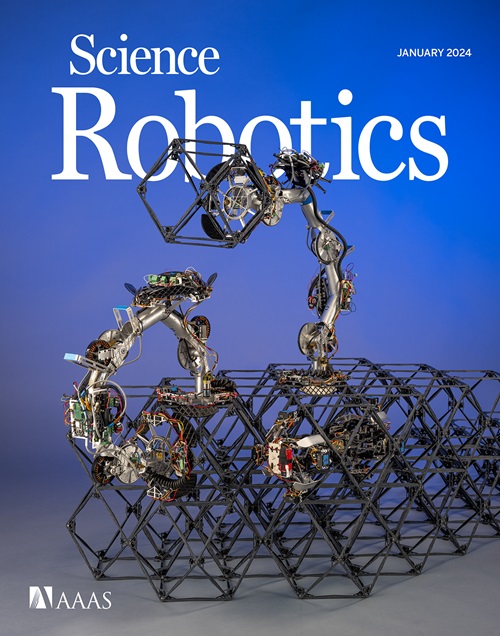FiBa 软体机器人爬行、攀爬、栖息和飞行。
IF 27.5
1区 计算机科学
Q1 ROBOTICS
引用次数: 0
摘要
本文介绍了一种制造轻型无系软体机器人的方法,这种机器人能够进行各种仿生物运动。将软体机器人从电力或气动动力中解脱出来仍然是该领域面临的突出挑战之一。开发功能性无系链软体机器人系统在很大程度上取决于减轻其重量;然而,软体机器人中气动网络致动器(气动网)的传统重量阻碍了无系链操作。为了应对这一挑战,我们开发了薄膜气球(FiBa)模块,大大减轻了软致动器的重量。FiBa 模块将横向弯曲的聚合物薄膜和三维打印的气动气球结合在一起,实现了各种运动模式。这些轻质的 FiBa 模块可作为模仿自然运动策略的无系软体机器人的构建模块。这些模块大大减轻了机器人的整体重量,可集成泵、阀门、电池和控制板等组件,从而实现无系绳操作。集成了电子元件的 FiBa 模块展示了四种生物启发运动模式,包括乌龟启发的爬行、尺蠖启发的攀爬、蝙蝠启发的栖息和瓢虫启发的飞行。总之,我们的研究为设计和定制具有高级功能的轻型无系软体机器人提供了另一种工具。我们的方法减轻了软体机器人的重量,为包括救灾、太空探索、遥感和搜救行动在内的广泛应用打开了大门,在这些应用中,轻型、无系绳软体机器人系统是必不可少的。本文章由计算机程序翻译,如有差异,请以英文原文为准。
Crawling, climbing, perching, and flying by FiBa soft robots
This paper introduces an approach to fabricating lightweight, untethered soft robots capable of diverse biomimetic locomotion. Untethering soft robotics from electrical or pneumatic power remains one of the prominent challenges within the field. The development of functional untethered soft robotic systems hinges heavily on mitigating their weight; however, the conventional weight of pneumatic network actuators (pneu-nets) in soft robots has hindered untethered operations. To address this challenge, we developed film-balloon (FiBa) modules that drastically reduced the weight of soft actuators. FiBa modules combine transversely curved polymer thin films and three-dimensionally printed pneumatic balloons to achieve varied locomotion modes. These lightweight FiBa modules serve as building blocks to create untethered soft robots mimicking natural movement strategies. These modules substantially reduce overall robot weight, allowing the integration of components such as pumps, valves, batteries, and control boards, thereby enabling untethered operation. FiBa modules integrated with electronic components demonstrated four bioinspired modes of locomotion, including turtle-inspired crawling, inchworm-inspired climbing, bat-inspired perching, and ladybug-inspired flying. Overall, our study offers an alternative tool for designing and customizing lightweight, untethered soft robots with advanced functionalities. The reduction of the weight of soft robots enabled by our approach opens doors to a wide range of applications, including disaster relief, space exploration, remote sensing, and search and rescue operations, where lightweight, untethered soft robotic systems are essential.
求助全文
通过发布文献求助,成功后即可免费获取论文全文。
去求助
来源期刊

Science Robotics
Mathematics-Control and Optimization
CiteScore
30.60
自引率
2.80%
发文量
83
期刊介绍:
Science Robotics publishes original, peer-reviewed, science- or engineering-based research articles that advance the field of robotics. The journal also features editor-commissioned Reviews. An international team of academic editors holds Science Robotics articles to the same high-quality standard that is the hallmark of the Science family of journals.
Sub-topics include: actuators, advanced materials, artificial Intelligence, autonomous vehicles, bio-inspired design, exoskeletons, fabrication, field robotics, human-robot interaction, humanoids, industrial robotics, kinematics, machine learning, material science, medical technology, motion planning and control, micro- and nano-robotics, multi-robot control, sensors, service robotics, social and ethical issues, soft robotics, and space, planetary and undersea exploration.
 求助内容:
求助内容: 应助结果提醒方式:
应助结果提醒方式:


